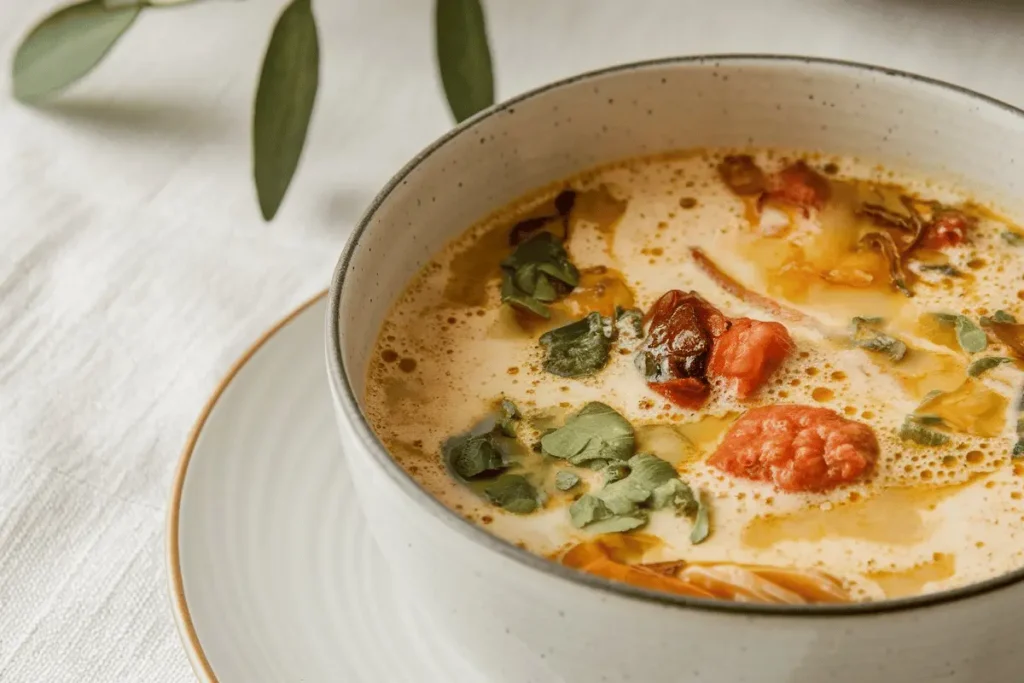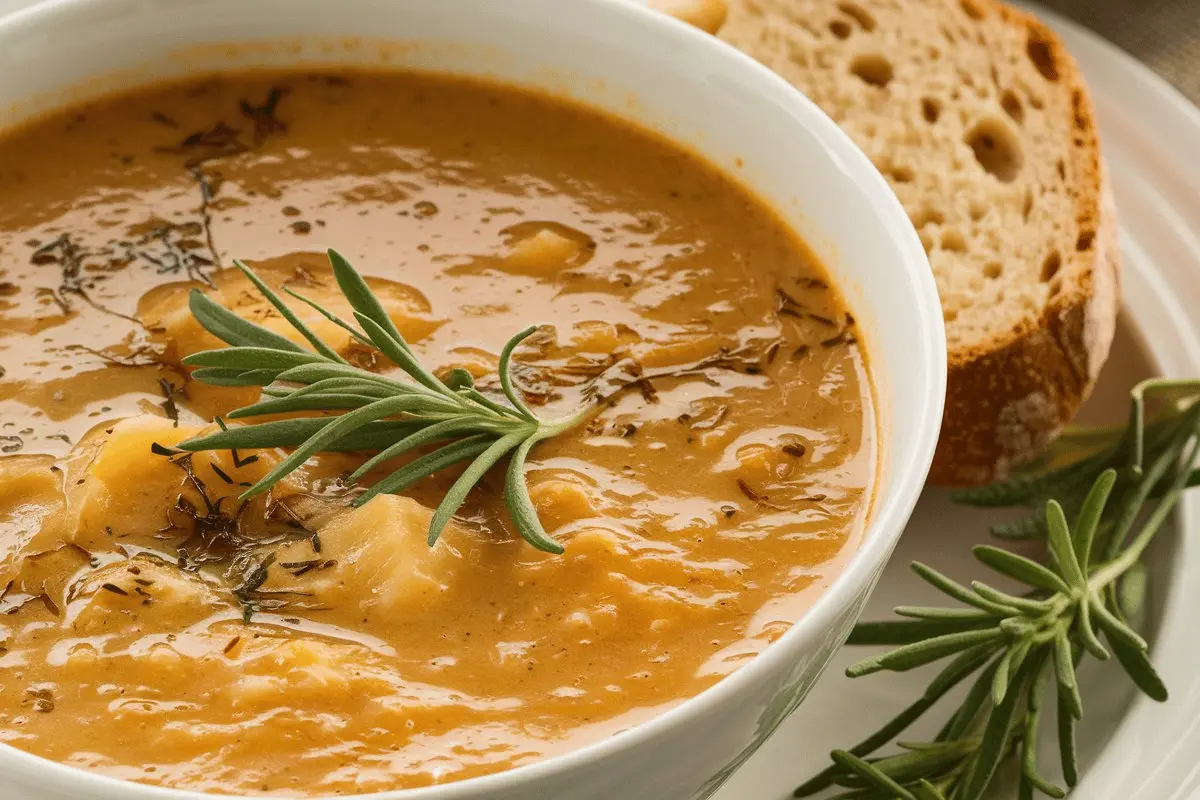Introduction:
When it comes to soups, the culinary world offers a vast array of choices. Among these, bisque and creamy soups often stand out, but they can also be confusing. What makes a soup a bisque vs creamy soup? Both types are rich, luxurious, and mouthwateringly delicious, but they are distinct. Understanding these differences not only enhances your culinary knowledge but also helps you appreciate the art of soup-making.
This guide will walk you through everything you need to know about what makes a soup a bisque vs creamy soup, from their origins and ingredients to their preparation and flavor profiles.
The Origins: What Makes a Soup a Bisque vs Creamy Soup Unique?
A Brief History of Bisque
The term bisque originates from France, where it was traditionally made from the shells of crustaceans like lobsters, shrimp, and crabs. The word “bisque” is believed to come from “biscuit,” meaning “twice cooked,” which reflects the method of roasting the shells and then simmering them to create a deeply flavorful broth. Over time, bisque evolved into a more refined dish, known for its smooth, creamy texture and rich taste.
The Evolution of Creamy Soups
Creamy soups have a more varied history, with roots in multiple cultures. Unlike bisque, which has a clear origin, creamy soups evolved from the basic idea of combining ingredients with a thickening agent—usually dairy—to create a smooth texture. These soups became particularly popular in Europe during the Renaissance, as dairy products became more accessible. The versatility of creamy soups has allowed them to feature a wide range of ingredients, from vegetables to meats.
Ingredients: What Makes a Soup a Bisque vs. Creamy Soup Different?
The Role of Shellfish in Bisque
At the heart of every authentic bisque is shellfish. Whether it’s lobster, shrimp, or crab, these crustaceans give bisque its distinctive flavor. But the magic doesn’t come just from the meat; it’s the shells that play the starring role. Roasted to bring out their deep, nutty flavor, these shells are then simmered to extract every bit of goodness. This shell-based broth is what truly defines what makes a soup a bisque vs creamy soup.
Other Common Ingredients in Bisque
Beyond shellfish, bisques often include a mirepoix (a mixture of onions, carrots, and celery), white wine, brandy or cognac, and a generous amount of cream. These ingredients are simmered together and then pureed to achieve a silky smooth consistency. Some recipes add tomato paste for additional depth and color, resulting in a bisque that is both rich and flavorful.
Dairy’s Role in Creamy Soups
In contrast, the primary feature that defines what makes a soup a bisque vs creamy soup is the use of dairy in creamy soups. Cream, milk, or a combination of both provides the foundation for the soup’s texture. The fat content in the dairy not only thickens the soup but also enhances the flavors, creating a smooth, rich mouthfeel that’s characteristic of creamy soups.
Common Ingredients in Creamy Soups
Creamy soups are versatile and can include a wide variety of ingredients. Vegetables like potatoes, mushrooms, and tomatoes are popular, as are meats like chicken or ham. A roux (a mixture of flour and butter) is often used to thicken the soup further. Herbs and spices, such as thyme, rosemary, and garlic, add depth and complexity to the flavors.
Preparation Techniques: How to Make a Bisque vs Creamy Soup

The Art of Roasting Shellfish for Bisque
One of the most important steps in making a bisque is roasting the shells of the shellfish. This process caramelizes the natural sugars in the shells, enhancing their flavor. The roasted shells are then simmered with aromatics, wine, and stock to create a deeply flavorful broth. This simmering process is crucial in defining what makes a soup a bisque vs creamy soup.
Simmering and Pureeing for a Smooth Texture
After the broth has simmered, it’s pureed until completely smooth. This step is what gives bisque its signature velvety texture. The soup is then strained to remove any remaining solids, leaving behind a rich, creamy liquid. The final touch is the addition of cream, which adds a layer of richness and helps to balance the flavors.
Building Flavors in Creamy Soups
For creamy soups, the process often begins with sautéing aromatics like onions and garlic in butter or oil. This step lays the foundation for the soup, ensuring that every ingredient added afterward will be infused with rich, savory flavors. The main ingredients are then added and cooked until tender, after which dairy is incorporated to create that signature creamy texture.
Slow Cooking for Depth of Flavor
Slow cooking is key to creating a deeply flavorful creamy soup. Once the ingredients are combined, the soup is simmered slowly to allow the flavors to meld together. This process helps to develop a rich, complex flavor that is characteristic of what makes a soup a bisque vs creamy soup. The soup is then pureed until smooth, resulting in a dish that is both comforting and satisfying.
Texture: What Makes a Soup a Bisque vs Creamy Soup Stand Out?
The Velvety Texture of Bisque
One of the hallmarks of bisque is its velvety texture, achieved through careful pureeing and straining. This process ensures that the soup is completely smooth, with no graininess or chunks. The addition of cream further enhances this texture, making each spoonful of bisque feel luxurious and indulgent. This velvety texture is a key factor in what makes a soup a bisque vs creamy soup.
The Rich, Smooth Texture of Creamy Soups
Creamy soups also boast a smooth texture, though it may not be as refined as that of a bisque. The thickness of a creamy soup can vary depending on the ingredients used and the amount of dairy added. Some creamy soups might have a slightly chunky texture if not fully pureed, but they still maintain a rich, comforting consistency that’s perfect for a hearty meal.
Flavor Profiles: What Makes a Soup a Bisque vs Creamy Soup?
Complex Flavors of Shellfish Bisque
The primary flavor in a bisque comes from the shellfish, which provides a deep, savory taste that is both rich and complex. Roasting the shells adds a layer of caramelized sweetness, while simmering them extracts every bit of flavor. The addition of wine or brandy introduces a slight acidity, balancing the richness of the soup and adding depth to the flavor profile.
Comforting Flavors of Dairy in Creamy Soups
In contrast, creamy soups are all about comfort. The dairy base provides a rich, smooth mouthfeel that makes each spoonful feel indulgent. Depending on the main ingredient, the flavor can range from earthy and savory, like in a cream of mushroom soup, to sweet and tangy, like in a cream of tomato soup. The dairy helps to mellow out any strong flavors, creating a dish that’s both satisfying and easy to enjoy.
Serving Suggestions: How to Serve Bisque vs Creamy Soup
Traditional and Modern Bisque Presentations
Bisque is traditionally served in small portions due to its rich and intense flavor. It’s often presented in shallow bowls, sometimes with a swirl of cream or a drizzle of brandy on top. Some chefs garnish bisque with a piece of the shellfish used in the soup, such as a lobster claw or a shrimp, adding a touch of elegance to the presentation. However, modern chefs have found creative ways to serve bisque, such as in a hollowed-out bread bowl or as part of a tasting menu.
Serving Creamy Soups with Classic and Creative Garnishes
Creamy soups are typically served in larger portions and are often accompanied by bread, crackers, or croutons. A sprinkle of fresh herbs or a dash of paprika on top can add a pop of color and flavor. To elevate a creamy soup, consider garnishing it with ingredients that add texture and contrast, such as crispy bacon bits, toasted nuts, or a drizzle of flavored oil.
Popular Recipes: What Makes a Soup a Bisque vs Creamy Soup?
Lobster Bisque Recipe
Lobster bisque is the quintessential bisque, celebrated for its luxurious texture and deep, rich flavor. Made from roasted lobster shells, this bisque is simmered with a mixture of vegetables, herbs, and cognac, then finished with cream. The result is a decadent soup that’s perfect for special occasions or whenever you’re in the mood for a culinary treat.
Shrimp Bisque Recipe
Shrimp bisque offers a slightly sweeter and lighter flavor compared to lobster bisque, but it’s no less delicious. The process is similar, with roasted shrimp shells forming the base of the soup. This bisque is often flavored with a touch of sherry or white wine, which complements the natural sweetness of the shrimp.
Cream of Mushroom Soup Recipe
Cream of mushroom soup is a classic comfort food, known for its earthy flavor and smooth texture. Made with a variety of mushrooms, onions, garlic, and cream, this soup is hearty and satisfying. It’s a perfect example of what makes a soup a bisque vs creamy soup, highlighting the versatility and comforting nature of creamy soups.
Cream of Tomato Soup Recipe
Cream of tomato soup offers a perfect balance of sweetness and acidity. Ripe tomatoes are simmered with onions, garlic, and herbs, then blended with cream to create a smooth, velvety soup. This dish is often paired with a grilled cheese sandwich, making it a beloved choice for both kids and adults alike.
Pairing Bisque and Creamy Soup with Wine
Wine Pairings for Bisque
When it comes to pairing wine with bisque, white wines are the way to go. A full-bodied Chardonnay, with its buttery texture, complements the richness of a lobster bisque beautifully. For shrimp bisque, a crisp Sauvignon Blanc offers a refreshing contrast that enhances the soup’s creamy texture.
Wine and Creamy Soup Pairings
For creamy soups, white wines that balance acidity and richness work best. A lightly oaked Chardonnay pairs well with cream of mushroom or chicken soups, while a Sauvignon Blanc or a light Pinot Noir can provide a nice contrast to the acidity in cream of tomato soup.
Conclusion: What Makes a Soup a Bisque vs Creamy Soup?
In the world of soups, the difference between a bisque and a creamy soup comes down to the details. Bisque, with its deep shellfish flavor and velvety texture, is a sophisticated dish that requires careful preparation. Creamy soups, on the other hand, are versatile and comforting, with a wide range of flavors and ingredients to explore. Whether you’re craving the luxurious taste of a bisque or the soothing comfort of a creamy soup, both options offer something unique and delightful.
FAQs
- What is the main difference between a bisque and a creamy soup? The key difference lies in the ingredients and preparation. Bisque is made with shellfish and has a smooth, velvety texture due to pureeing and straining. Creamy soups are more varied and use dairy to achieve their smooth texture.
- Can bisque be made without shellfish? While traditionally made with shellfish, some variations use vegetables or other seafood. However, these may not have the same deep flavor as a traditional bisque.
- Is bisque always served hot? Yes, bisque is typically served hot to maintain its rich, deep flavors. However, some variations, like chilled avocado bisque, can be served cold.
- What is the best way to reheat bisque? Reheat bisque slowly on the stove over low heat, stirring frequently to prevent the cream from curdling. Avoid reheating in the microwave, as it can cause uneven heating.
- Can creamy soups be frozen? Yes, but they may separate when reheated. To prevent this, reheat slowly and whisk the soup to recombine the ingredients, ensuring a smooth texture.
